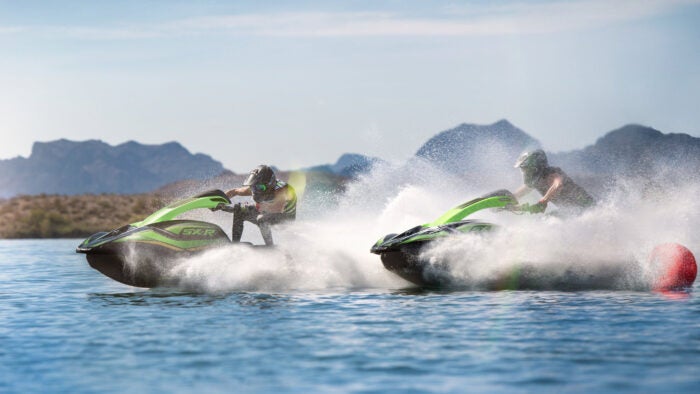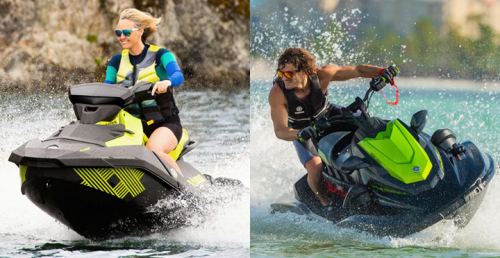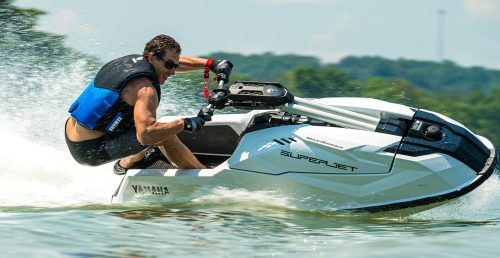The Toys Of Summer

Four craft with a decidedly old-school approach and a thoroughly modern flair
Summer is in full swing, and PWC enthusiasts all over the Northern Hemisphere are getting out on the water. For the majority, that’s on a craft that’s cushy, big and powerful. But what about those who long for the days of small, agile craft that spun and leaped, maybe even let you learn a few showy tricks? You know, something that may be a little more challenging but rewards the effort…and pegs the fun factor.
Enter the “toys of summer,” four craft that take a decidedly old-school approach but ratchet things up with a thoroughly modern flair. We’ve assembled four of our favorites.
Ready to get truly wet and wild?
Sea-Doo Spark Trixx ($9,099)
It’s no surprise this freestyle-minded variation on Sea-Doo’s Spark tops our list of play toys. Barely over 9’ in length and weighing in at a scant 425 pounds, the Trixx is one of the smallest craft still available in the personal watercraft market and boasts a somewhat loose hull design that loves to slide or spin out into a 180. Crank the bars and those half spins easily turn into full 360s. Time the next wave just right and you’ll launch upwards in a way most of today’s behemoth models have forgotten.
The Trixx’s biggest strengths, however, are found in a trio of add-ons that transform the ride experience. Everyone’s favorite is the extended range variable trim. Tilt the nozzle upwards, punch the throttle and shift your weight behind the saddle and the bow lifts into a wheelie. Finesse the throttle, bars and balance and you’ll be spinning like a top. Extendable handlebars raise to provide even more leverage (and comfort) while angled chocks at the rear of the footwells provide a somewhat horizontal surface to stand up when the rest of the craft goes vertical. Yes, the Trixx features only a 90hp engine but with its lightweight composite construction and diminutive size, it more than gets the job done.
Yamaha SuperJet ($10,699)
Hardcore freestyle types may bemoan the death of the lightweight two-stroke standups of old, but it’s hard to argue with the fact that modern alternatives open up the standup world to more riders than ever before. Yamaha’s SuperJet boasts several features that dramatically shorten the learning curve. For one, the hull itself is just far more stable. The four-stroke SuperJet also now benefits from a speed-governed learning mode which lops off the top 15-percent of the power band. The combo lets newcomers stay upright and begin to carve through their first turns in a fraction of the time usually required and at much slower, novice-friendly speeds.
Once riders are up to the challenge, a torquey TR-1 engine leaps out of the hole with surprising force, while race-inspired tubular handlebars take the back-breaking labor out of holding the handle pole. Bonus? The latter is adjustable to fine-tune the fit. Our only real negatives are the lack of padding on the top side of the rider tray gunwales and the craft’s somewhat boxy, no-graphics appearance in stock form. Neither are enough to make us forget the fun.
Yamaha JetBlaster (Starting at $10,899)
Yes, Yamaha’s JetBlaster features a couple of the Spark Trixx’s same potent add-ons – in this case namely the extended-range electric trim, footwell chocks, taller/wider handlebars for greater leverage and an advantageous horsepower-to-weight ratio – but don’t think for a second it’s just a competitor’s copycat. Instead, the ’Blaster is a much more aggressive, more powerful craft aimed at the high-performance rider that doesn’t just want to just carve buoys like the GP crowd or blast full speed into the horizon.
Examples? That extended trim doesn’t focus on wheelies but instead lightening up the nose of the craft to produce muscular leaps out of the water or a powerful launch off an ocean wave. Those footwell chocks let riders lock in when standing or stay in control when cranking a forceful spin or tweaked leap. Yamaha’s TR-1 engine cranks out 110 horsepower, a number that from a seat-of-the-pants perspective often seems surprisingly low. Finally, its size and fiberglass-based construction allow the modern ’Blaster to venture comfortably into bigger waters and rougher conditions.
Kawasaki Jet Ski SX-R 160 ($11,999)
Kawasaki’s SX-R 160 isn’t nearly as light and playful as the original Jet Ski designs that supercharged the PWC market in the ’80s and ’90s, but it’s far easier to ride for beginners, rewards experienced riders with amazing handling and boasts a whopping 160 horsepower from the 1,498cc four-cylinder under the hood. That’s a potent triple play for this newest generation of Jet Ski standup. The icing on the cake? The SX-R looks just as good as it performs, with a sleek and sexy design that pays homage to the original but is yet almost futuristic at the same time. Don’t expect to perform old-school aerial nose stabs or quick 180 spinouts on this 9’ 6” long, 551-pound beast. And yes, like the Yamaha, please add some padding to the top of the tray gunwales for comfort when boarding in deep water.
Grab a handful of throttle and crank the bars as you lean in to a corner, however, and you’ll likely forget those concerns and discover a craft that carves up the water with absolute precision and makes anyone standing in the tray feel like a true racer. Top speed? North of 60 mph.
Get PersonalWatercraft.com in your Inbox!
Like PersonalWatercraft.com on Facebook
Comments
Most Popular

2025 Yamaha JetBlaster PRO 2-Up Review

Remembering the Sea-Doo XP

2024 Kawasaki Jet Ski STX 160X Review

Whatever Happened to the Wetbike?

2025 Yamaha JetBlaster Review





















 Your Privacy Choices
Your Privacy Choices